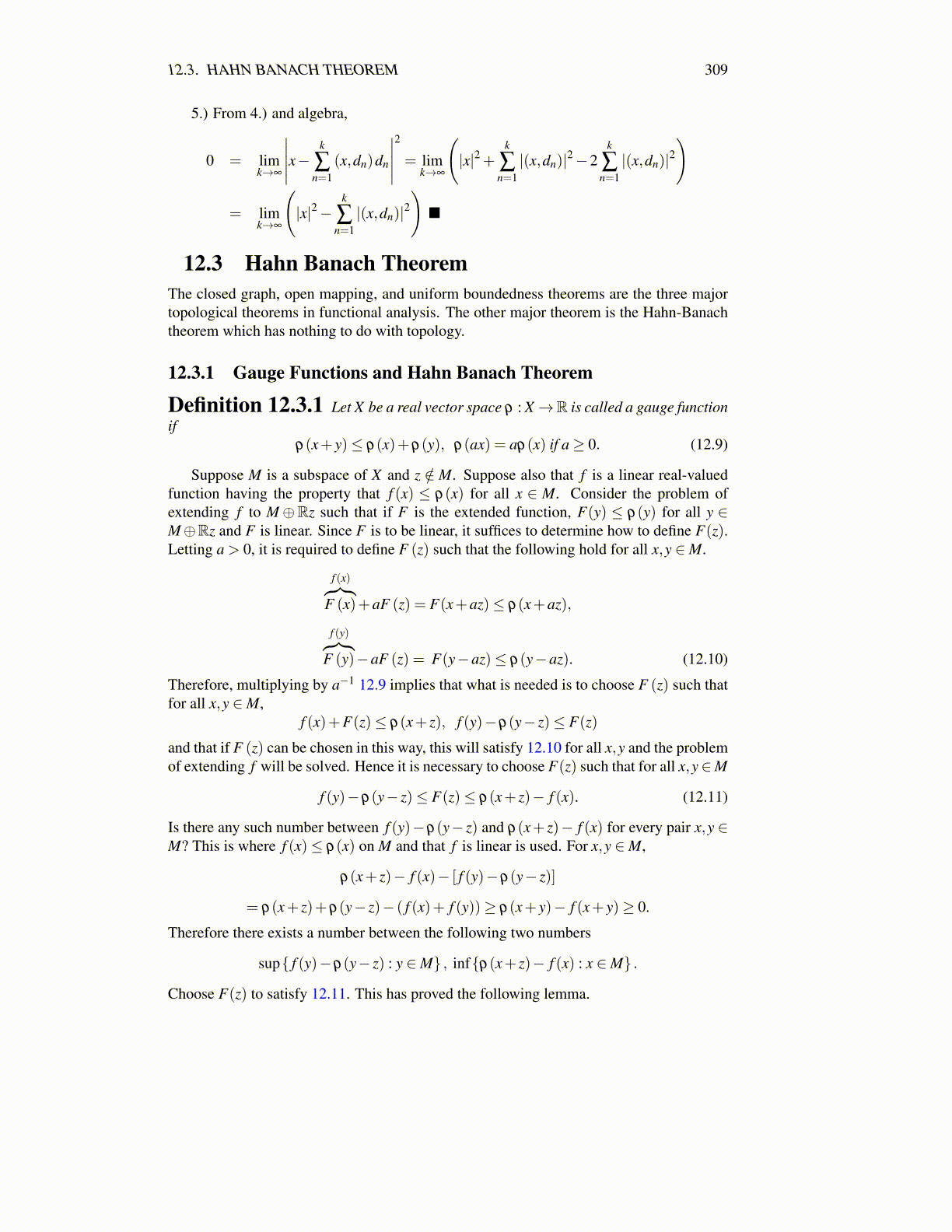
12.3. HAHN BANACH THEOREM 309
5.) From 4.) and algebra,
0 = limk→∞
∣∣∣∣∣x− k
∑n=1
(x,dn)dn
∣∣∣∣∣2
= limk→∞
(|x|2 +
k
∑n=1|(x,dn)|2−2
k
∑n=1|(x,dn)|2
)
= limk→∞
(|x|2−
k
∑n=1|(x,dn)|2
)■
12.3 Hahn Banach TheoremThe closed graph, open mapping, and uniform boundedness theorems are the three majortopological theorems in functional analysis. The other major theorem is the Hahn-Banachtheorem which has nothing to do with topology.
12.3.1 Gauge Functions and Hahn Banach Theorem
Definition 12.3.1 Let X be a real vector space ρ : X→R is called a gauge functionif
ρ(x+ y)≤ ρ(x)+ρ(y), ρ(ax) = aρ(x) if a≥ 0. (12.9)
Suppose M is a subspace of X and z /∈ M. Suppose also that f is a linear real-valuedfunction having the property that f (x) ≤ ρ(x) for all x ∈ M. Consider the problem ofextending f to M⊕Rz such that if F is the extended function, F(y) ≤ ρ(y) for all y ∈M⊕Rz and F is linear. Since F is to be linear, it suffices to determine how to define F(z).Letting a > 0, it is required to define F (z) such that the following hold for all x,y ∈M.
f (x)︷︸︸︷F (x)+aF (z) = F(x+az)≤ ρ(x+az),
f (y)︷︸︸︷F (y)−aF (z) = F(y−az)≤ ρ(y−az). (12.10)
Therefore, multiplying by a−1 12.9 implies that what is needed is to choose F (z) such thatfor all x,y ∈M,
f (x)+F(z)≤ ρ(x+ z), f (y)−ρ(y− z)≤ F(z)
and that if F (z) can be chosen in this way, this will satisfy 12.10 for all x,y and the problemof extending f will be solved. Hence it is necessary to choose F(z) such that for all x,y∈M
f (y)−ρ(y− z)≤ F(z)≤ ρ(x+ z)− f (x). (12.11)
Is there any such number between f (y)−ρ(y− z) and ρ(x+ z)− f (x) for every pair x,y ∈M? This is where f (x)≤ ρ(x) on M and that f is linear is used. For x,y ∈M,
ρ(x+ z)− f (x)− [ f (y)−ρ(y− z)]
= ρ(x+ z)+ρ(y− z)− ( f (x)+ f (y))≥ ρ(x+ y)− f (x+ y)≥ 0.
Therefore there exists a number between the following two numbers
sup{ f (y)−ρ(y− z) : y ∈M} , inf{ρ(x+ z)− f (x) : x ∈M} .
Choose F(z) to satisfy 12.11. This has proved the following lemma.